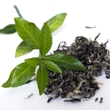
Green tea, black tea, oolong tea and pu-erh tea are all made from the Camellia sinensis plant. But their preparation, effects, side effects and caffeine content all vary.
Green tea accounts for about 20% of the world’s tea production. One cup typically contains under 50 mg of caffeine – the lowest amount in all of these teas. Unlike the other teas, green tea is not fermented. It’s prepared by steaming, pan frying, and then drying the leaves of the Camellia sinensis plant. This preparation method sets green tea apart because it maintains the polyphenol content of the leaves. One polyphenol in particular, epigallocatechin gallate (EGCG), seems to be responsible for many of the health benefits linked to green tea, and also some of the safety concerns. There’s some evidence that drinking green tea can reduce the risk for a variety of conditions, including heart disease, endometrial cancer, high cholesterol, high blood pressure, ovarian cancer, and Parkinson disease. But there’s also some concern about potential liver injury from green tea extract products due to their very high EGCG content. Tell patients that taking green tea extract with less than 600 mg of EGCG daily seems to be safe for most healthy adults. And taking green tea extracts with food might also lower the risk of liver injury. Green tea as a beverage is almost certainly safe for the vast majority of people when consumed in moderation.
Black tea, oolong tea and pu-erh tea are all made from the fermented leaves of the Camellia sinensis plant. Oolong tea is fermented for less time than black tea. Pu-erh tea is made in a two-step process – first the leaves are parched, and then they are fermented. The various fermentation processes affect the caffeine content and overall chemical properties of the final beverages. While green tea is rich in EGCG, these fermented teas contain theaflavins. Theaflavins are antioxidants believed to have both heart health and anti-cancer effects. Because oolong tea is fermented for less time than black tea, it contains moderate amounts of both theaflavins and EGCG compared to the other two teas. Black tea contains the highest amount of caffeine at up to 100 mg per cup, followed by oolong tea and pu-erh tea which both contain about 50-60 mg per cup, although this can vary. Because of their higher caffeine content, drinking any of these fermented teas can improve mental alertness. But remind patients that consuming more than 600 mg of caffeine daily can cause side effects such as headache, irregular heartbeat, vomiting, and nervousness.
To learn more about green tea, black tea, oolong tea or pu-erh tea, check out our recently updated monographs.
The information in this brief report is intended for informational purposes only, and is meant to help users better understand health concerns. This information should not be interpreted as specific medical advice. Users should consult with a qualified healthcare provider for specific questions regarding therapies, diagnosis and/or health conditions, prior to making therapeutic decisions. Copyright © 2024 NatMed. Commercial distribution or reproduction prohibited. NatMed is the leading provider of high-quality, evidence-based, clinically-relevant information on natural medicine, dietary supplements, herbs, vitamins, minerals, functional foods, diets, complementary practices, CAM modalities, exercises and medical conditions. Monograph sections include interactions with herbs, drugs, foods and labs, contraindications, depletions, dosing, toxicology, adverse effects, pregnancy and lactation data, synonyms, safety and effectiveness.
